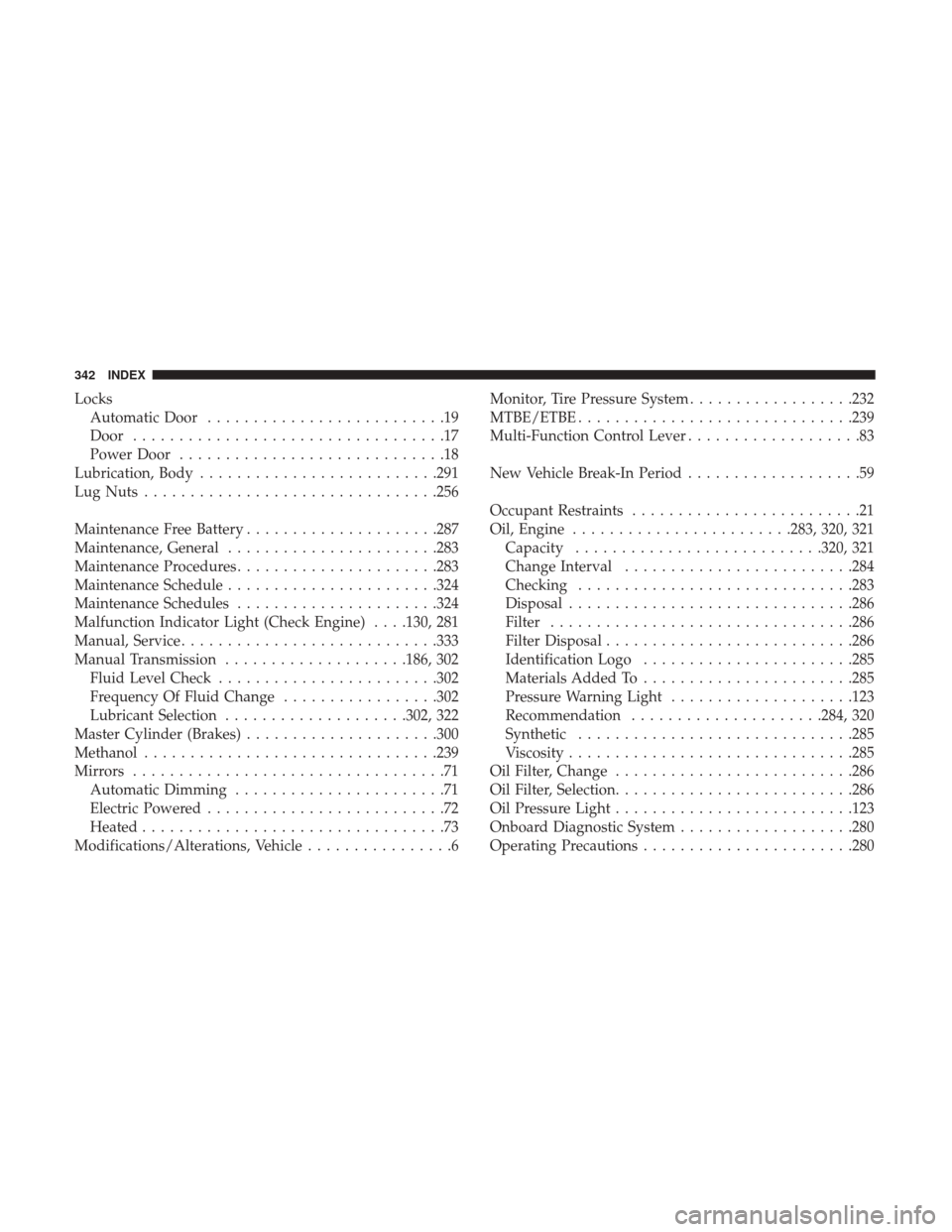Page 61 of 350

WARNING!(Continued)
•If your vehicle is equipped with a split rear seat,
make sure the tether strap does not slip into the
opening between the seatbacks as you remove
slack in the strap.
Transporting Pets
Air Bags deploying in the front seat could harm your
pet. An unrestrained pet will be thrown about and
possibly injured, or injure a passenger during panic
braking or in a collision.
Pets should be restrained in the rear seat in pet har-
nesses or pet carriers that are secured by seat belts.
ENGINE BREAK-IN RECOMMENDATIONS
A long break-in period is not required for the engine
and drivetrain (transmission and axle) in your vehicle.
Drive moderately during the first 300 miles (500 km).
After the initial 60 miles (100 km), speeds up to 50 or
55 mph (80 or 90 km/h) are desirable. While cruising, brief full-throttle acceleration within the
limits of local traffic laws contributes to a good break-in.
Wide-open throttle acceleration in low gear can be
detrimental and should be avoided.
The engine oil installed in the engine at the factory is a
high-quality energy conserving type lubricant. Oil
changes should be consistent with anticipated climate
conditions under which vehicle operations will occur.
For the recommended viscosity and quality grades,
refer to “Maintenance Procedures” in “Maintaining
Your Vehicle.”
CAUTION!
Never use Non-Detergent Oil or Straight Mineral
Oil in the engine or damage may result.
NOTE: A new engine may consume some oil during its
first few thousand miles (kilometers) of operation. This
should be considered a normal part of the break-in and
not interpreted as a problem.
2
THINGS TO KNOW BEFORE STARTING YOUR VEHICLE 59
Page 287 of 350

American Petroleum Institute (API) Engine Oil
Identification Symbol
This symbol means that the oil has
been certified by the American Petro-
leum Institute (API). The manufac-
turer only recommends API Certified
engine oils.
This symbol certifies 0W-20, 5W-20,
0W-30, 5W-30 and 10W-30 engine oils.
CAUTION!
Do not use chemical flushes in your engine oil as
the chemicals can damage your engine. Such dam-
age is not covered by the New Vehicle Limited
Warranty.
Engine Oil Viscosity (SAE Grade) — 1.4L Engine
SAE 5W-30 engine oil approved to FCA Material Stan-
dard MS-6395 such as Pennzoil, Shell Helix or equiva-
lent is recommended for all operating temperatures.
This engine oil improves low temperature starting and
vehicle fuel economy. The engine oil filler cap also shows the recommended
engine oil viscosity for your engine. For information on
engine oil filler cap location, refer to “Engine Compart-
ment” in this section.
Lubricants which do not have both the engine oil
certification mark and the correct SAE viscosity grade
number should not be used.
Synthetic Engine Oils
You may use synthetic engine oils provided the recom-
mended oil quality requirements are met, and the
recommended maintenance intervals for oil and filter
changes are followed.
Synthetic engine oils which do not have both the engine
oil certification mark and the correct SAE viscosity
grade number should not be used.
Materials Added To Engine Oil
The manufacturer strongly recommends against the
addition of any additives (other than leak detection
dyes) to the engine oil. Engine oil is an engineered
product and its performance may be impaired by
supplemental additives.
7
MAINTAINING YOUR VEHICLE 285
Page 344 of 350

LocksAutomatic Door ..........................19
Door ..................................17
Power Door .............................18
Lubrication, Body ......................... .291
Lug Nuts ............................... .256
Maintenance Free Battery .....................287
Maintenance, General ...................... .283
Maintenance Procedures ..................... .283
Maintenance Schedule ...................... .324
Maintenance Schedules ..................... .324
Malfunction Indicator Light (Check Engine) . . . .130, 281
Manual, Service ........................... .333
Manual Transmission ....................186, 302
Fluid Level Check ....................... .302
Frequency Of Fluid Change .................302
Lubricant Selection ....................302, 322
Master Cylinder (Brakes) .....................300
Methanol ............................... .239
Mirrors ..................................71
Automatic Dimming .......................71
Electric Powered ..........................72
Heated .................................73
Modifications/Alterations, Vehicle ................6Monitor, Tire Pressure System
..................232
MTBE/ETBE ............................. .239
Multi-Function Control Lever ...................83
New Vehicle Break-In Period ...................59
Occupant Restraints .........................21
Oil, Engine ....................... .283, 320, 321
Capacity .......................... .320, 321
Change Interval ........................ .284
Checking ............................. .283
Disposal .............................. .286
Filter ................................ .286
Filter Disposal .......................... .286
Identification Logo ...................... .285
Materials Added To ...................... .285
Pressure Warning Light ....................123
Recommendation .....................284,
320
Synthetic ............................. .285
Viscosity .............................. .285
Oil Filter, Change ......................... .286
Oil Filter, Selection ......................... .286
Oil Pressure Light ......................... .123
Onboard Diagnostic System ...................280
Operating Precautions ...................... .280
342 INDEX